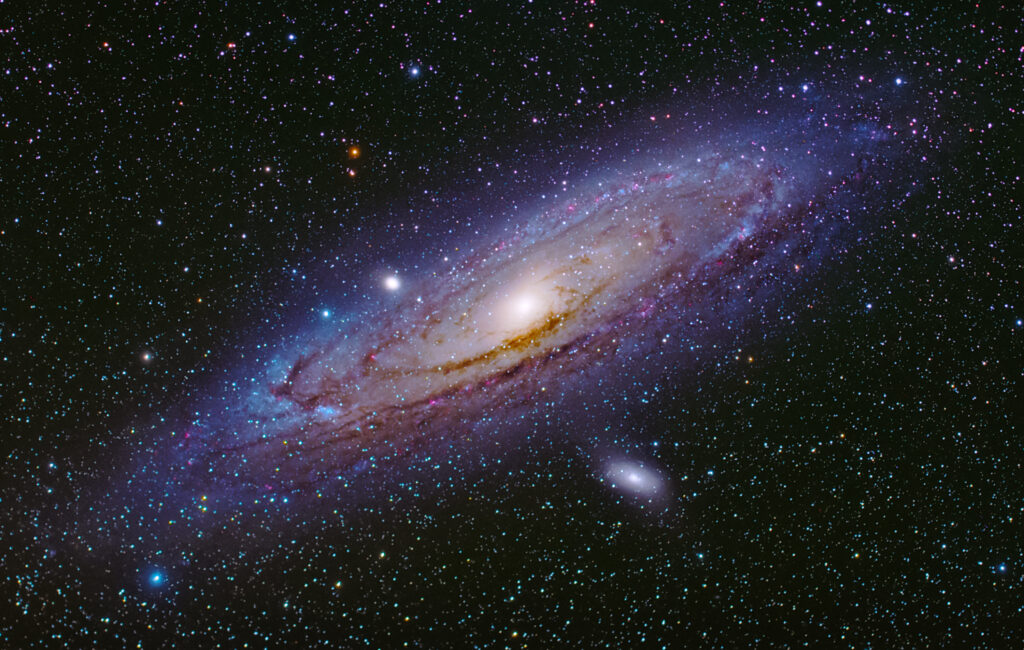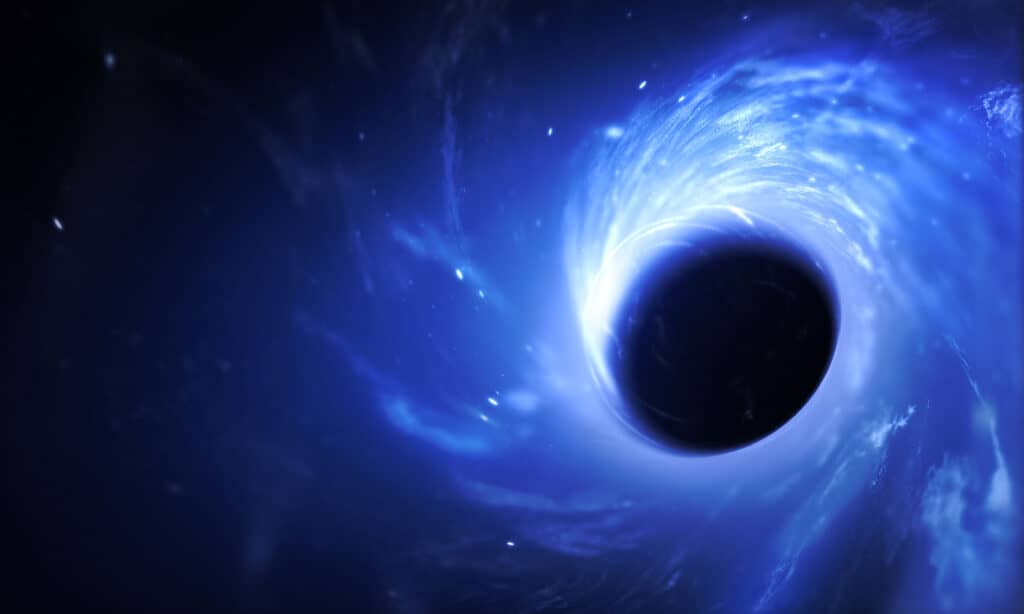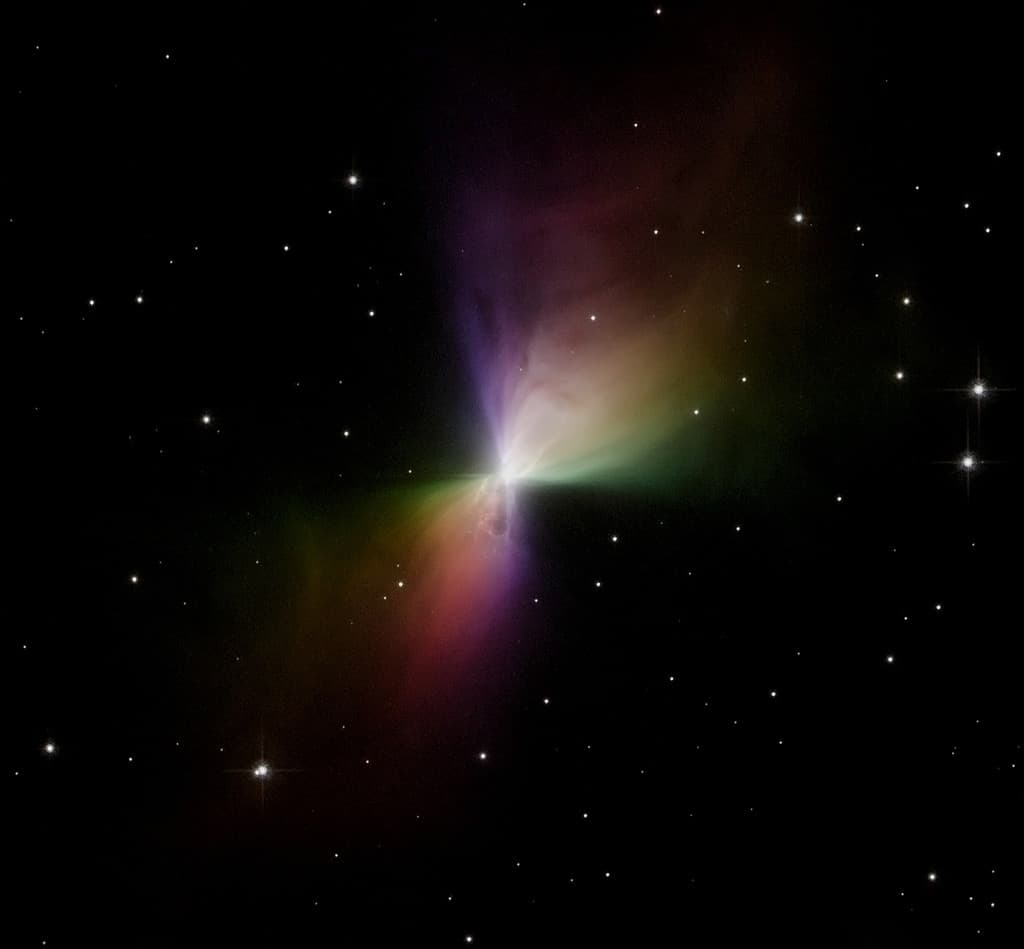Outer space: a boundless, enigmatic expanse that has captivated humanity’s imagination for as long as we could imagine. But what’s the temperature out there in the void? Is it as freezing as we often picture, or is there more to the story? Contrary to popular belief, space itself is not inherently cold and doesn’t even have a temperature as we understand it. Here on Earth and other non-voids, temperature is a measure of the movement and energy of particles. Whereas in space a complex dance of particles and radiation occurs and manifests both heat and cold. So, how cold is outer space, really? We know it’s cold beyond cold, but simply putting a number to it doesn’t get at the whole story. Join us on this cosmic journey to unravel this most vexing questions.
Additionally, for those new to astrophysics, you can view a table of potentially unfamiliar terms in table format that’s ordered by their appearance in the article here: Astrophysics Terms and Concepts.

The much-studied Messier 31, or the Andromeda Galaxy, is a hard-to-grasp 2.537 million light years away — and it’s considered the closest spiral galaxy to us!
©Antares_StarExplorer/Shutterstock.com
The Environment of Outer Space
Near-Vacuum Nature
A vacuum in the wide cosmos is not absolute emptiness, but rather a zone with relatively few particles. Space’s near-vacuum condition contributes to its unusual temperature properties. With fewer particles colliding and exchanging energy, the classic sense of “cold” or “hot” becomes a hazy concept.
The Cosmic Dance – Plasma, Electromagnetic Radiation, and Cosmic Rays
A cosmic dance of plasma, electromagnetic radiation, and cosmic rays is taking place in space. These elements, though few, have an important influence in determining the temperature of a given location. Cosmic rays, high-energy particles zipping through space, and the ever-present radiation create a warm backdrop in the otherwise chilly expanse. The dance is complex, intriguing, and necessary for grasping the thermal nature of space.
Heating Up of Space
Not all of space is ice cold. The temperature surges around the blazing stars where nuclear fusion occurs. Sunlight interacts with particles, generating heat and forming some of the universe’s hottest places. The sun energy collected by air particles keeps our planet warm. Much of space outside of our Goldilocks bubble is made up of extremes. Mercury has blistering days and frigid nights, but Uranus and Neptune have extremely cold surface temperatures.
Why is Space So Empty?
Space’s apparent emptiness is caused by cosmic forces, expansion, and the nature of matter itself. The universe has been expanding since the Big Bang, dispersing matter across immense distances. Gravity attracts matter into galaxies and stars, leaving huge gaps in between. Though invisible, dark matter and dark energy exert forces that contribute to this vacuum. Temperature and pressure variables hinder the creation of complex structures in certain places, and our perception limitations can result in us to think of space as emptier than it is. This void is not a desolate wasteland, but rather a dynamic interaction of forces that tells the tale of the universe’s birth, growth, and ongoing evolution.

Though we often depict black holes as black and round, we actually can’t directly see a black hole, since light inside its event horizon can’t escape. It’s a truly invisible phenomenon.
©iStock.com/Petrovich9
The Universe’s Size, Shape, and Expansion
Theories about the Universe
The size and shape of the cosmos are subjects of everlasting fascination and continuing inquiry. According to current theories, the cosmos is filled with dark energy, a mysterious force that is driving the expansion of space. This non-zero vacuum energy pervades the universe and influences its temperature. Understanding dark energy can help explain why space is frigid in some places and hot in others. It’s a puzzle that scientists are still piecing together, each discovery adding a new dimension to our understanding of the universe.
The Expanding Universe and Its Effect on Temperature
Imagine blowing up a balloon with dots on its surface. As the balloon expands, the dots move farther apart. This analogy helps us grasp the concept of a rapidly expanding universe. Evidence from redshifts of distant galaxies shows that the universe is stretching, and this expansion affects temperature. In regions far from galaxies and stars, the expansion leads to cooling, creating cold voids. It’s a dynamic process that’s continually shaping the thermal landscape of space.
The Interstellar Medium
Beyond the glowing stars and swirling galaxies lies the interstellar medium, a region where temperatures radically drop. Here, particles are spread thin, and heat transfer occurs primarily through radiation. The cold is intense, with molecular gas clouds reaching temperatures as low as 10 Kelvin. These cold regions are not simply empty, chilly voids. Rather, they are also the birthplace of stars and an important part of the cosmic cycle. The interstellar medium reminds us that cold is a presence, not an absence, in the grand dance of the universe.

The Boomerang Nebula is 5,000 light-years away and is the coldest place we’ve observed in our universe.
©NASA, ESA and The Hubble Heritage Team (STScI/AURA) – Original / License
So How Cold is Cold, in Space Terms?
The average temperature, such as it is, of the universe is a halting 10 Kelvin, or negative 441.67 degrees Fahrenheit. Further, the coldest place in the known universe is the Boomerang Nebula (also known as the Bow Tie Nebula, since it looks like a giant bowtie), located 5,000 light years away from Earth in the constellation Centaurus. It has a temperature of one degree Kelvin, making it colder than space itself. Translating this temperature to Earth terms, one degree Kelvin is about negative 457.87 degrees Fahrenheit. (Zero degree Kelvin, or absolute zero, describes a state of no motion or heat whatsoever, pegged at negative 460 degrees Fahrenheit, or negative 273.15 degrees Celsius.) For reference, the coldest temperature ever recorded on our beautiful blue planet stands at negative 128.60 Fahrenheit, captured in 2011 in Vostok, Antarctica.
Challenges of Human Exploration
The Impact of Microgravity, Vacuum, and Radiation
The harsh realities of near-vacuum environments make hard and deadly work of space exploration. Scientists continue to study the effects of microgravity on the human body. And the vacuum of space presents various challenges to maintaining pressure and breathable air. Radiation, which must be continuously contended with in space, endangers both human health and technology. Temperature adds a new level of complication. Extreme cold in some areas has an impact on equipment, fuel efficiency, and human well-being. Because of these difficulties, human exploration of the cosmos is both a fascinating adventure and a formidable logistical undertaking.
Life in the Cold – Organisms in Space
In the seemingly inhospitable cold of space, life can still find a way. Thanks to experiments by NASA, we now know that certain microorganisms, known as extremophiles, can not only survive, but even thrive, in the vacuum and freezing temperatures of outer space. Tardigrades, or “water bears,” have become famous for their resilience in the face of extreme conditions. These findings raise intriguing questions regarding the possibility of life beyond Earth and call into question our understanding of where life might exist. Instead of being a barrier, space’s cold becomes a frontier for exploration and discovery, hinting at the universe’s unfathomable possibilities.
Let’s consider what sort of lifeforms might be out there:
Carbon-Based Lifeforms
Tardigrades
As already mentioned, these so-called “water bears” are famous for their resilience in the face of extreme conditions. They can withstand freezing temperatures, radiation, and vacuum, posing questions about what other carbon-based organisms might endure such conditions.
Speculative Complex Organisms
While known examples of space-proof organisms, such as our “water bear” friends, are microscopic, it’s not entirely outside the realm of possibility that more complex carbon-based organisms could adapt to space’s environment. These creatures would likely have unique metabolic pathways, insulation methods, and radiation-resistant features. Think of organisms with specialized cells or structures to capture and utilize sparse energy sources, such as cosmic radiation or distant starlight.
Non-Carbon-Based Lifeforms
Silicon-Based Life
Silicon, like carbon, can form four bonds with other atoms, making it a candidate for building life. A science fiction fan favorite, speculative silicon-based organisms might be more heat-resistant and could exist in extremely cold or hot environments.
Ammonia-Based Solvent Life
In extremely cold regions, water would be frozen, but ammonia remains liquid at much lower temperatures. Organisms using ammonia as a solvent instead of water could theoretically exist in the frigid void of space.
Exotic Chemistry Life
Beyond familiar elements, exotic chemistry could give rise to entirely new forms of life. This might include life based on entirely different chemical reactions, perhaps utilizing plasma or supercritical fluids. It’s possible that some unique configurations would allow them to adapt to the cold, sparse environment of outer space.
And of course, we simply don’t know what we don’t know. But based on what we do know, we can reasonably speculate and wonder.

Humans have a long way to go before we get to the scenario depicted here.
©Gorodenkoff/Shutterstock.com
The Temperature of Outer Space – A Closer Look
Measuring the Cold
As noted above, the temperature of space is not uniform. Rather, it varies depending on location, proximity to stars, and other factors. Scientists measure the cold of space using specialized instruments like bolometers and radiometers. These devices detect the faint thermal radiation emitted by objects in space, allowing for precise temperature measurements. From the scorching vicinity of stars to the numbing cold of intergalactic voids, these tools help unravel the thermal tapestry of the universe.
The Impact of Temperature on Space Missions
Temperature plays a pivotal role in space missions, satellites, and other equipment. Extreme cold can affect the functionality of spacecraft, causing materials to contract and making fuels less efficient. Engineers must consider these factors in designing missions, adding insulation, heating elements, and utilizing materials that can withstand the temperature extremes of space. The intersection of engineering and thermodynamics in space exploration is a testament to human ingenuity and adaptability.
Cosmic Background Radiation
The cosmic microwave background (CMB) is a faint glow that permeates the universe. It’s a relic of the Big Bang, with a uniform temperature of 2.7 Kelvin, offering a glimpse into the early universe. The CMB represents the point when matter and photons aligned in temperature, and since then, the photons of the CMB have redshifted over time. It’s like a cosmic fingerprint, providing key insights into the universe’s structure, composition, and the profound cold of the cosmic background.
Cold and Getting Colder
Space is colder now than ever before, a phenomenon tied to the expansion of the universe. As the universe grows, it cools, stretching the fabric of space and causing temperatures to drop in certain regions. This cooling process is a fascinating aspect of cosmology, reflecting the dynamic, ever-changing nature of the universe.
Exposure to Space
What happens if a human is exposed to the vacuum and cold of space? Though a gruesome thing to consider, it’s worth digging into if we ever hope to become more than a one-planet species. Contrary to popular myths, freezing is unlikely because heat transfer is limited. Instead, an exposed astronaut would face challenges like decompression. The cold of space, though daunting, is not as simple as it might seem. This exploration dispels common misconceptions and adds depth to our understanding of space’s thermal environment.
Lack of Air Pressure
The air in the lungs would expand, leading to potential rupture if not exhaled quickly.
Decompression Sickness
As deep-sea divers here on Earth are well aware of, the sudden loss of pressure would cause nitrogen bubbles to form in the blood, leading to pain and neurological effects.

As we’ve learned from our deep-sea exploits here on Earth, extreme decompression sickness can be deadly and we have more to fear from it than whale sharks.
©Katja Tsvetkova/Shutterstock.com
Swelling
Body fluids would quickly vaporize and produce notable swelling.
Loss of Consciousness
Oxygen deprivation would lead to unconsciousness within 15 seconds, followed by brain damage and death.
Radiation Exposure
With no atmosphere to shield our bodies, harmful radiation from the sun could cause burns and long-term damage.
Temperature Extremes
The body could experience scorching or freezing temperatures, depending on its location in space.
No Explosive Decompression
Despite what popular culture may tell you, the body would not explode, as skin and tissue provide bonding of the body.
Potential for Recovery
Brief exposure with quick re-pressurization and medical treatment might allow for recovery, though effects would likely be severe.
The cold of space, though daunting, is just one aspect of a complex and lethal environment.
Conclusion
Outer space, a realm that has intrigued and challenged humanity for generations, is more than a mere void. It’s a tapestry of temperatures, a perilous dance of particles and radiation, a place of extremes where heat and cold coexist in a delicate imbalance. From the blazing stars to the frigid interstellar medium, space’s temperature tells a story of creation, evolution, and deep mystery.
We’ve journeyed through the environment of outer space, explored the universe’s expansion, delved into the challenges of human exploration, and peered into the complexities of temperature measurement. We’ve uncovered life’s resilience in the face of extreme cold and speculated on the forms life might take in the far reaches of the harsh universe.
In the words of Carl Sagan, “The cosmos is within us. We are made of star-stuff. We are a way for the universe to know itself.” The temperature of space, like the supernovae-forged iron in our hemoglobin, is a part of that complex cosmic connection, a thread that ties us to the vast and wondrous expanse of the universe.
Astrophysics Terms and Concepts
| Term or Concept | Description |
|---|---|
| Vacuum | The absence or near-absence of particles. |
| Kelvin | A unit of temperature; 0 Kelvin is absolute zero. |
| Absolute Zero | The lowest possible temperature, where particles have no motion or heat. |
| Plasma | A hot state of matter consisting of positively charged ions and free electrons. |
| Electromagnetic Radiation | Waves of the electromagnetic field, including light and radio waves. |
| Cosmic Rays | High-energy protons and atomic nuclei that move through space. |
| Interstellar Medium | The matter that exists in the space between stars in a galaxy. |
| Goldilocks Zone | The habitable zone around a star where conditions are right for liquid water to exist. |
| Boomerang Nebula | The coldest known place in the universe. |
| Dark Energy | A form of energy that is driving the expansion of the universe. |
| Dark Matter | Unseen matter that doesn’t emit or interact with electromagnetic forces but has gravitational effects. |
| Universe’s Expansion | The universe is expanding, moving galaxies apart. |
| Big Bang Theory | The prevailing cosmological model that explains the origin of the universe. |
| Redshift | The shift of light to longer wavelengths as it moves away from an observer. |
| Bolometers and Radiometers | Instruments used to measure temperature and radiation. |
| Cosmic Microwave Background (CMB) | The thermal radiation left over from the Big Bang. |
| Microgravity | Very low gravity environment in space. |
| Extremophiles | Organisms that can thrive in physically or geochemically extreme conditions. |
| Tardigrades | Microscopic organisms known for their resilience. |
| Silicon-Based Life, Ammonia-Based Solvent Life, Exotic Chemistry Life | Hypothetical forms of life. |
| Effects of Exposure to Space | Includes Lack of Air Pressure, Decompression Sickness, Swelling, Loss of Consciousness, Radiation Exposure, Temperature Extremes. |
The photo featured at the top of this post is © Triff/Shutterstock.com
Thank you for reading! Have some feedback for us? Contact the AZ Animals editorial team.







